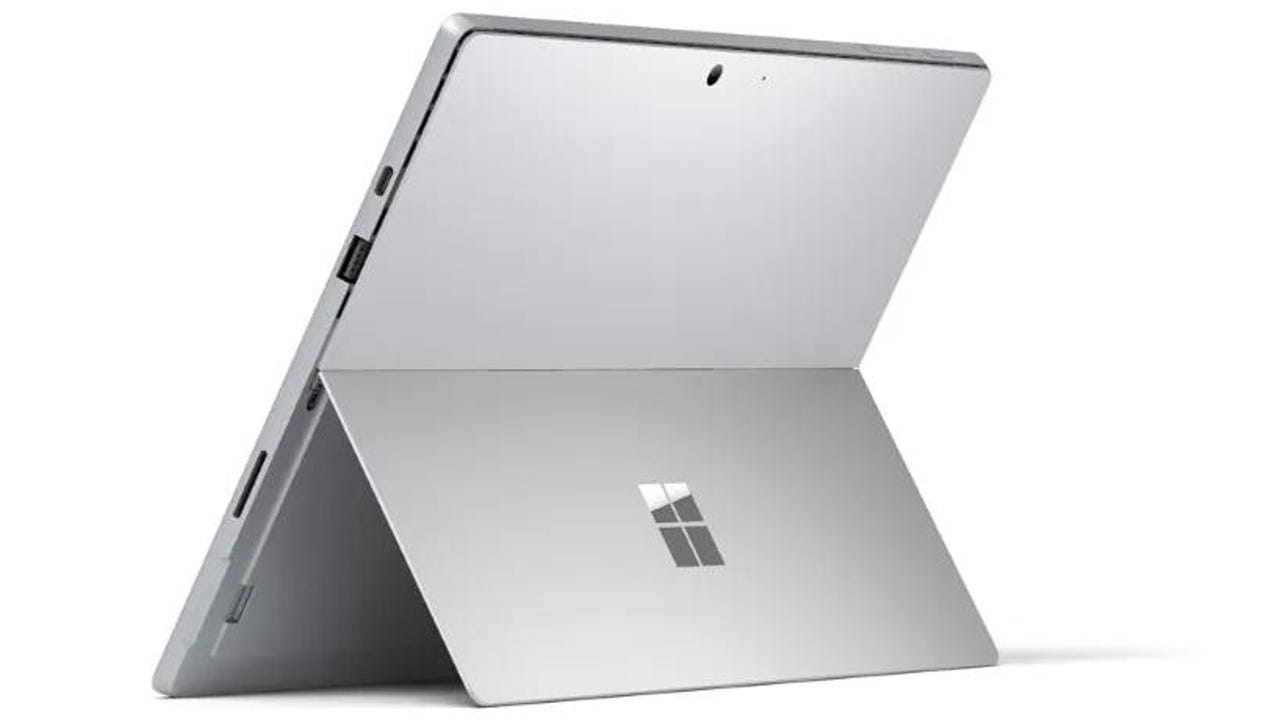First look: Surface Pro 7 follows a familiar path


If you've used a Surface Pro in the past four years, the only change you'll notice is the USB Type-C port on the right side.
See als
Don't mess with success. That's clearly the driving principle of Microsoft's hardware engineers when it comes to the Surface Pro line.
The Surface Pro 7, which goes on sale today, is the latest iteration in a line that has remained virtually unchanged in outward appearance since the debut of the Surface Pro 4 in October 2015. It's exactly the same size and shape as last year's Surface Pro 6, and you have to look carefully to notice the one change: A new USB Type-C port on the right side, where the mini-DisplayPort connector used to be located.
On the inside, this year's Surface Pro gets an upgrade to Intel's 10th-generation Ice Lake processors. The basic business models, available in platinum and black, include i5 and i7 processors with Intel Iris Plus graphics, 8GB or 16GB of RAM, and solid state storage ranging from 128GB to 1TB. Prices for those models start at $899 and go to $2299 for a maxed-out configuration.
A new entry-level model uses the i3 CPU with 4GB of RAM, 128GB of storage, and Intel UHD Graphics, at a starting price of $749.
All models support Intel's Wi-Fi 6 standard (802.11ax compatible) and Bluetooth 5.0. Other subtle hardware upgrades in this year's model include a magnetometer and dual far-field Studio Mics that should improve speech recognition and voice communications, especially in noisy environments.
Although the fifth-generation Surface Pro included an LTE option, Microsoft didn't include mobile connectivity in the Surface Pro 6, and the Surface Pro 7 models offer no LTE options either.
All those listed configurations ship with Windows 10 Home; the Surface Pro Signature Type Cover with backlit keys and a large trackpad is an additional $160, and the most recent Surface Pen will set you back another $100. Because the Surface Pro 7 uses the same keyboard connector as its predecessors, you can recycle an older Type Cover with the new models.
As with its predecessors, the Surface Pro 7 is a 2-in-1 device that isn't for everyone. Without the Type Cover, it's a thin, lightweight tablet. Snap the Type Cover in place and extend the hinge, and you have the equivalent of a laptop. If you've used a Surface Pro before, the experience will be familiar, and if you've already made up your mind on "lappability" (the ability to type comfortably with the Surface Pro balanced in your lap), the new model won't change your mind.
The USB Type-C connector feels like it was added under duress; its performance is limited to USB 3.1 speeds, and it doesn't support the Thunderbolt 3 standard. In casual testing, I was able to connect a variety of inexpensive USB Type-C multi-port adapters for Ethernet connectivity, external storage devices, and 4K video over HDMI. When I tried several docking stations built with Thunderbolt 3 support, the results were unsatisfactory.
Must-see offers
Unsurprisingly, the Microsoft Surface Dock, which uses the blade-style Surface Connector to enable access to power, dual video outputs, and external ports, works perfectly.
I've spent the past few days with a Surface Pro 7 review unit provided by Microsoft. It's equipped with an i5-1035G4 CPU, 8GB of RAM, and 256GB of storage, along with a bright-red Signature Type Cover and a matching Surface Pen.
The biggest advantage of the new U Series Ice Lake processors is power management. With only a few days of hands-on testing, I wasn't able to get definitive measurements of expected battery life. But initial measurements of power use suggested that these devices will probably get more than nine hours of everyday usage.
The real advantage is in standby performance; in Connected Standby mode, my i5-equipped Surface Pro 7 machine used only about 2% of available battery live overnight, which is noticeably better than earlier Intel Core processor generations. The default power settings have the system set to hibernate after 36 hours, which eliminates the possibility of finding the battery drained unexpectedly because you didn't use the device for a week.
The Surface Pro 7 is also remarkably quick to wake up, typically coming back to life and signing me in with the built-in Windows Hello facial recognition before the Type Cover had even hit the desk. That's startlingly faster than a fifth-generation Surface Pro, which takes a few seconds to perform the same wake-up routine.
For a four-year-old hardware design, the Surface Pro 7 doesn't feel dated, except for the incomplete USB Type-C support. But its real competition is still on the horizon. The Arm-equipped Surface Pro X, which adopts a similar form factor but is designed to get hours more battery life, comes out in two weeks. As I noted earlier this month, Windows 10 on Arm offers its own set of limitations, but for anyone obsessed with the ability to work long hours without external power, it might be the preferred option.
I'll have a full review of the Surface Pro 7 after I've had a longer period to put it through its paces.